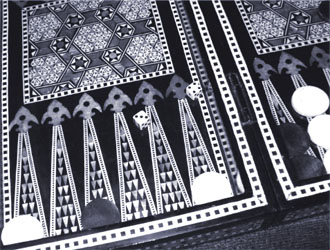|
| Magriel's NYT Columns |
 Today, many variations of the traditional opening rolls and responses are seen. The modern style of opening play stresses quick development rather than safety. Early in the game there is more emphasis on constructive plays designed to seize key points.
Today, many variations of the traditional opening rolls and responses are seen. The modern style of opening play stresses quick development rather than safety. Early in the game there is more emphasis on constructive plays designed to seize key points.
The most valuable points to control are the 5-point and the 20-point (the opponent’s 5-point). Accordingly, many games begin with violent struggles for these two vital points.
In the diagrammed position, White has begun the game with the opening roll of 4-3. Instead of making the traditional play, 12/15, 12/16, bringing two builders down from his mid-point (the 12-point), White has made the more aggressive and increasingly popular play, 1/5, 12/15, splitting his back men in an effort to seize Black’s 5-point.
|
| Black to play 4-1. |
Black should not give White the opportunity to make the 5-point without a struggle. Therefore, it is essential for Black to drive White off this point by hitting him with the 1, 6/5*.
The more difficult question is how to play the remaining 4. In practice, few players find the best move. The common response, 5/1*, hitting White on the 1-point, appears strong and aggressive, but is a serious error.
6/5*/1*, hitting two of White’s men, puts White off balance and temporarily prevents White from improving his position. The weakness of this play is that it fails to do anything constructive for Black. With it, Black does not start to build any valuable points.
Indeed, it does not even create any builders for new points. Rather than improving his position, this play will leave Black in worse shape. As White begins to reenter, Black will find himself without any logical follow-through. For example, a full-scale attack to close White out is premature. In addition, the blot on the 1-point, if not hit, will be a liability.
The correct play is 6/5*, 24/20, hitting White on the 5-point and then splitting to the 20-point. With this play, Black makes an effort to gain control of two vital points, the 5-point and the 20-point. Thus, Black begins to develop his men to build a strong position.
By contrast, 6/5*/1* does not even start to make a valuable point and so Black cannot possibly hope to improve his structure. The correct play gives White more return shots, but quick development — not safety — is what counts at the beginning of the game.
Rollout
 Tom Keith 2013 |
|
Money play Centered cube Black rolls 4-1 1296 games with VR Checker play: 2-ply Cube play: 3-ply Red |
| 4-1: | Game | G | BG | Equity | ||||
| 1 | 24/20, 6/5* |
W L |
.4853 .5147 |
.1242 .1539 |
.0055 .0079 | −0.0941 |

| (b) |
| 2 | 13/9, 6/5* |
W L |
.4829 .5171 |
.1390 .1681 |
.0075 .0136 | −0.1048 | (0.0107) | |
| 3 | 6/5*/1* |
W L |
.4697 .5303 |
.1298 .1582 |
.0055 .0077 | −0.1366 | (0.0425) | (a) |

|
|

